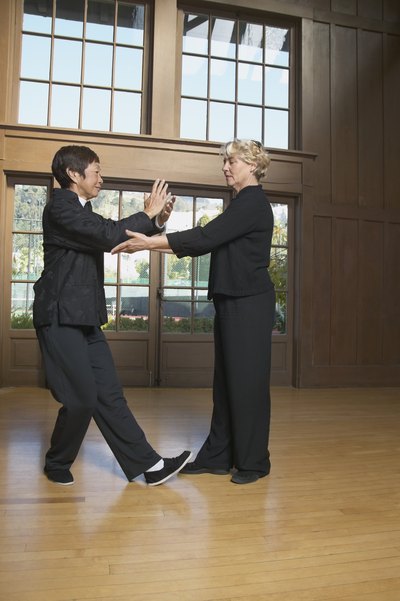
Tai chi, an ancient Chinese martial art, combines systematic breathing with slow, specific movement to enhance balance, range of motion and relaxation. A 2010 review of studies published in American Journal of Health Promotion concluded that among its numerous benefits, the regular practice of tai chi improves bone density, provides heart protection, reduces falls in the elderly and bolsters immune function. The best way to learn tai chi is to work with a master in a class or through one-on-one sessions; DVDs are another way to visually understand this moving meditation. Precision and patience are required as you develop the moves.
Video of the Day
Tai chi intends to help the practitioner feel grounded, which helps promotes stability and balance. Many movements sink you toward the ground and focus on proper body alignment. One movement flows into the next, as you shift your weight from leg to leg. The names of moves are often inspired by animals and birds. Complex classes can contain dozens of movements, while simple, beginning classes focus on 13.
Meditation and deep breathing are intrinsic to the practice of tai chi. This encourages internal calming and peacefulness as well as the cleansing of stale air. In addition, these techniques help your muscles relax and release tension.
A full understanding of the principle of yin and yang is required for tai chi practice. Yin and yang simply means the practice of opposites. Yin refers to qualities of water, such as coolness or stillness, while yang is more aggressive and powerful, like fire. To be healthy, your yin and yang should be in balance -- and tai chi aims supports this. In tai chi, yin and yang practice shows up as stepping forward and then backward, or to the right and then the left. Tai chi postures also open and close or move up and down. Sometimes, depending on the class and the teacher's evaluation of the students' needs, a class may be more yin in nature, or more yang.
Most tai chi sessions begin with the opening stance, which has you stand with the feet hip distance and arms draped toward the floor, palms facing the thighs. Here, you settle into the breath and mindset needed to move on. The stance may seem simple, but requires observation of your posture and complete release of tension. After this, you move into positions such as "part the horse's mane," "white crane spreads it's wings," "play the lute," and "retreat and repulse monkey."
Tai Chi is based on eight precise movements called Bamen Wubu. "Bamen" means "eight doors" or "eight gates," and "Wubu" means "five steps." These movements are: ward off, roll back, squeeze and push, pluck and split, and elbow strike and bump. Because of the precision of each, work with an experienced practitioner to master each.
Tai chi variations and methods of practice can vary wildly. Some classes incorporate the principles of qigong, a slower and simpler practice of breathing and less-precise movement that also hails from China. You're encouraged to watch a class first, before joining, to see if the particular practice is right for you. For many people, it takes time to appreciate the quiet, measured pace of tai chi.
Original article and pictures take www.livestrong.com site
Комментариев нет:
Отправить комментарий